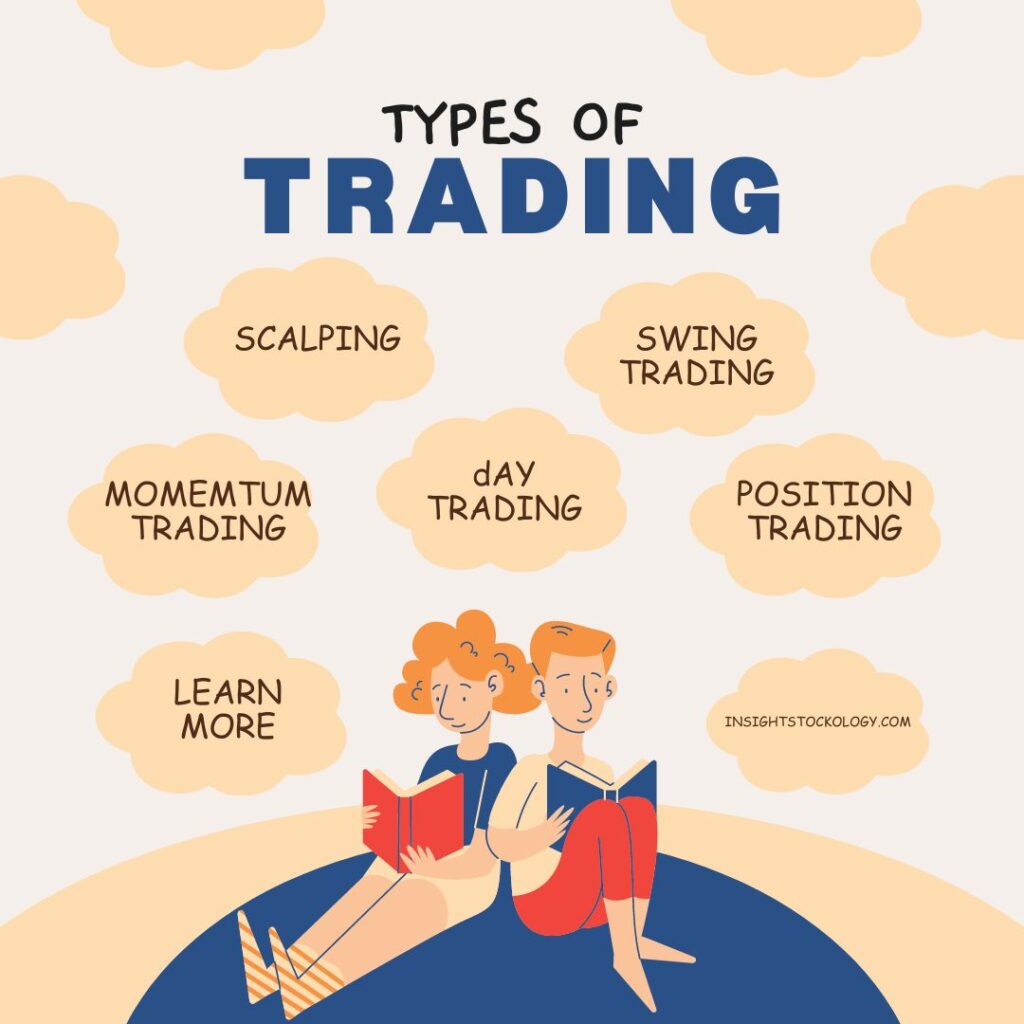Welcome to insightstockology.com, in today’s article we are gonna discuss about “What is Trading and How it Works.”
Stock market Trading involves buying and selling securities for profit, attracting individuals, institutional investors, and financial institutions. It contrasts with traditional investing due to its short-term focus. In the stock market, traders seize opportunities in constantly fluctuating share prices. To engage in share trading successfully, understanding its fundamentals is crucial, given the need for active participation compared to the buy-and-hold strategy of investing.
IMPORTANT HIGHLIGHTS
- Definition and Function: Trading refers to the buying and selling of financial assets such as stocks, bonds, commodities or currencies with the aim of making a profit. It works on the principle of supply and demand, where traders speculate on the future price movements of these assets. Various trading platforms, such as stock exchanges or online brokerage firms, facilitate trading by providing a marketplace for buyers and sellers to execute transactions.
- Market Dynamics and Analysis: Successful trading requires a deep understanding of stock market dynamics and the ability to analyze various factors that affect asset prices. Traders use both fundamental analysis, which involves assessing an asset’s intrinsic value based on economic, financial and qualitative factors, and technical analysis, which involves studying past price movements and chart patterns to predict future trends. Additionally, market sentiment, geopolitical events, and macroeconomic indicators play an important role in shaping trading decisions.
- Risk Management and Strategy: Trading inherently involves risk, and effective risk management is essential to preserve capital and maximize returns. Traders employ various strategies, such as diversification, stop-loss orders and position sizing, to reduce risk and protect against adverse market movements. Additionally, a well-defined trading plan with clear entry and exit criteria helps traders stay disciplined and avoid making emotional decisions. Continuous learning, adaptation to market conditions, and psychological resilience are key ingredients to successful trading.
Table of Contents

What is Trading and How It Works?
Trading involves buying and selling securities like stocks, bonds, currencies, commodities, and derivatives to make a profit. It’s a short-term focus, contrasting with traditional long-term investing. Traders, including individuals and institutions, often engage in the stock market, taking advantage of constantly fluctuating share prices to maximize profits.
To trade successfully in the share market, a solid grasp of share trading fundamentals is crucial. Investing and trading differ, with trading requiring active participation in financial markets compared to the buy-and-hold strategy of investing.
In the stock market, traders engage in buying and selling shares of listed companies, taking advantage of the constant fluctuations in share prices to make a profit. The term “trading” specifically refers to the daily buying and selling of securities to capitalize on price changes.
In essence, trading is the exchange of stocks between investors in the stock market, facilitated by online platforms that have made these markets accessible to a broader audience. This dynamic activity emphasizes the need for a good grasp of trading fundamentals, given its daily involvement in the financial markets.
Understanding how trading works involves a seamless process that enables the buying and selling of stocks on the stock exchanges. Once a company’s stocks are listed, investors engage in transactions through stockbrokers or brokerage firms, acting as intermediaries.
- Trade Execution Process:
- Investors place buy orders through brokers, who then transmit these orders to the stock exchange.
- The stock exchange matches buy and sell orders in real-time, agreeing on a price for the transaction.
- Confirmation is swiftly communicated to the broker, who informs the investor of the executed trade.
- The settlement cycle ensures the actual transfer of stock ownership, now streamlined to T+2 days.
2. Role of Trading and DEMAT Accounts:
- Trading accounts serve as interfaces between investors and Demat accounts.
- Funds for stock purchases reside in the trading account, and withdrawals are also facilitated from this account.
- Opening an online trading account involves submitting essential documents like PAN and Aadhar cards to a stockbroker.
Understanding the trade execution process, the role of trading accounts, and the distinction between cash and margin accounts is fundamental to comprehending the mechanics of trading in the financial markets.
History of Trading
The history of trading spans human civilization, originating from the agricultural revolution. Initially, various societies engaged in a barter system, exchanging goods and services without a standardized measure of value. Recognizing the inconvenience, the introduction of money revolutionized trading by providing a universal standard.
Stock market trading emerged with joint-stock companies in Europe, notably with the Dutch East India Company being the first to publicly trade shares in Amsterdam. This marked a significant step in economic development and played a role in European imperialism. Informal stock markets began appearing in different European cities.
Following the triumph of joint-stock companies in promoting economic growth and geographical expansion, they became a cornerstone of the financial realm. The Bombay Stock Exchange, founded in 1875, stands as the inaugural platform for online trading in India and Asia. Both the Bombay Stock Exchange and the National Stock Exchange in India serve as the primary arenas for stock market trading.
The concept of automated trading systems traces back to Richard Donchian in 1949. By the 1980s, rule-based trading gained popularity, especially among notable traders like John Henry. The 1990s saw the availability of trading models for purchase, and technology advancements made these strategies more accessible to retail investors.
The automated trading system, driven by algorithm-based software, began managing portfolios in the mid-1990s. The first unsupervised service, Betterment by Jon Stein, was launched in 2008, marking a significant development.
Types of Trading

There are several types of trading is available in stock market, those are:-
Day Trading:-
In stock market Day trading involves buying and selling stocks within a single trading day, typically from 9:15 am to 3:30 pm on weekdays[Indian Market Only]. The primary objective is to capitalize on short-term price movements in various financial instruments like stocks, options, and futures. Day traders aim to profit from small-scale fluctuations in the Net Asset Value (NAV) of stocks, holding positions for just minutes or hours.
Successful day trading requires a deep understanding of market volatility, proficiency in market matters, and a keen sense of stock value fluctuations. It is a fast-paced form of trading, where traders utilize strategies such as technical analysis and momentum to make quick decisions. Unlike long-term investors, day traders prioritize immediate gains over the fundamental value of securities.
While day trading offers the potential for quick profits, it comes with significant risks. Traders must stay informed about market headlines, economic reports, and other factors influencing stock prices throughout the day. This form of trading is commonly practiced by experienced investors due to the need for a comprehensive understanding of market dynamics.
Swing Trading:-
In stock market Swing trading is a stock market strategy designed to capitalize on short-term trends and patterns, typically within 1 to 7 days of purchasing a stock. Traders employ technical analysis to understand stock movement patterns, aiding in the execution of their investment goals. While swing trading generally involves holding a position for more than one trading session, it rarely extends beyond several weeks or a couple of months.
The primary objective of swing trading is to capture a portion of a potential price move. Traders may target either volatile stocks with significant movement or more stable stocks, tailoring their approach to individual preferences. Regardless of the chosen stock, the process involves identifying the likely direction of an asset’s price, entering a position, and securing a portion of the profit if the anticipated move materializes.
Momentum Trading:-
In stock market momentum trading involves capitalizing on a stock’s significant value movement, either upward or downward. Traders identify stocks breaking out or poised to break out. During upward momentum, traders sell their stocks for higher-than-average returns, while during downward movement, they purchase stocks to sell at a higher price later.
Think of momentum like a train ride: it starts slow, accelerates, maintains high velocity, and then decelerates. Momentum investors focus on the middle part of the ride when the train is at its highest velocity. They chase alpha returns by investing in trending stocks, commonly known as hot stocks. The hotter the stock (measured by growth over time), the more appealing it is for momentum investors. Conversely, stocks trending down are considered cold. In essence, momentum traders thrive on the dynamics of a stock’s movement to achieve optimal returns.
Position Trading:-
Position trading is a strategy where investors hold securities for an extended period, typically months, to capitalize on the long-term potential of stocks. Unlike day traders, position traders are not concerned with short-term price fluctuations or daily news unless it fundamentally alters their long-term perspective on the investment.
This style of trading is particularly suitable for individuals who are not market professionals or regular participants, as position traders make fewer than 10 trades in a year. The primary goal is to buy an investment with the expectation that it will appreciate over time, focusing on the overall growth rather than short-term market movements.
Scalping:-
Scalping, also known as micro-trading, is a strategy within intraday trading that focuses on reaping numerous small profits in a single market day. Unlike day-trading, scalping involves holding securities for a very short period, often just a few minutes. Traders engaging in scalping need market experience, proficiency, and a keen awareness of market fluctuations, as transactions must be executed promptly.
The essence of scalping lies in the assumption that most stocks will complete the initial stage of a movement, but predicting subsequent movements remains uncertain. Scalpers aim to accumulate as many small profits as possible, differing from the mindset of letting profits run in order to optimize trading results. Successful scalpers aim for a higher ratio of winning trades, keeping profits roughly equal to or slightly larger than losses.
Trading Vs Investing
| Trading | Investing |
| 1.Investing is akin to a test match, where the primary object is to purchase stocks for the long term and nature capital growth. | 1.Trading mirrors the dynamics of a T20 match, emphasizing short-term gains by investing larger sums with the goal of earning minimal profits swiftly. |
| 2. The approach is conservative, aiming to minimize risk by steering clear of short-term market volatility. | 2.The approach is riskier, as traders actively seek opportunities in short-term market volatility, a realm marked by high unpredictability. |
| 3. Investors typically hole onto their investments for extended periods, ranging from years to even decades. | 3.Traders typically buy and sell stocks within seconds to a few months, constantly adapting to market changes and mis-pricings. |
| 4. The focus in on wealth creating over the long term, with the goal of earning a regular passive income through dividends and bonds issues, coupled with long-term capital gains. | 4.The focus here is on short-term profits, requiring regular analysis to identify the narrowest mis-pricings and adapt to market shifts. |
| 5. Once invested, tracking requires less effort, making it a more passive strategy | 5.To achieve extraordinary returns, traders must consistently develop successful strategies and put in excessive effort to track their investments. |
Current Impact of Online Trading
Over the years, the internet has revolutionized stock market trading, making it more accessible and convenient for individuals, through online trading in India.
The popularity of Mutual Funds has soared with the advent of online trading. Investors now have direct access to a plethora of mutual funds and securities, empowering them to trade more actively and speculatively, enhancing their chances of profitability.
Advantages of Online Trading:
- Convenience and Accessibility:
- Online stock market trading stands out as the most convenient method, allowing individuals to buy or sell shares from any remote location with an internet connection. This not only saves time but also provides ease of access.
2. Cost-Effective Transactions:
- The brokerage fees in online stock trading are significantly lower compared to the commissions charged by traditional full-service brokers. This cost-effectiveness attracts traders looking to optimize their expenses.
3. Greater Control and Independence:
- Investors utilizing online trading accounts enjoy greater control, as they can place buy and sell orders independently without the interference of a broker. This autonomy eliminates the need for a middleman, streamlining the trading process and reducing overall costs.
4. Nearly Instantaneous Transactions:
- Online trading enables swift transactions, allowing investors to capitalize on market opportunities promptly. The ability to review options independently without relying on a broker enhances decision-making speed.
5. Enhanced Market Awareness:
- Engaging in online trading fosters a deeper understanding of financial markets. Investors actively participating in their money management build a habit of being personally involved, reducing the risk of fund misuse by third parties.
6. Predictive Analysis:
- Online traders develop the ability to predict market behavior and anticipate stock price movements. Handling their finances independently, traders become more adept at distinguishing good investment opportunities from unfavorable ones over time.
The Unmatched Benefits of Online Trading:
- Independence from Stockbrokers:
- Online stock market trading minimizes reliance on stockbrokers, reducing the chances of human errors and providing traders with more control over their transactions.
2. Quicker Transactions:
- Online stock market trading, with its click-of-a-button functionality, accelerates the trading process, crucial for the rapid pace of Intraday trading. This speed ensures quicker exchanges and potentially faster earnings.
3. Increased Exposure and Flexibility:
- Online stock market trading platforms offer a comprehensive view of stocks and finances, exposing traders to detailed statistics. With location flexibility through mobile apps, investors can manage their stocks from anywhere, gaining exposure to various stock exchanges simultaneously.
4. Real-Time Monitoring and Alerts:
- Online stock market trading allows investors to monitor stocks in real-time, providing precise stock prices instantly. Customizable alerts through email and SMS ensure traders stay informed and make timely decisions.
5. Cost-Effective and Single-Platform Access:
- Online stock market trading proves cheaper than phone trading for both brokers and traders. Major stockbrokers have adopted online platforms to save costs, offering a single platform for access to multiple stock exchanges, streamlining the trading experience.
[If you want to start your trading journey you can use – Angleone]









3 thoughts on “What Is Trading And How It Works- For Beginners 2024”